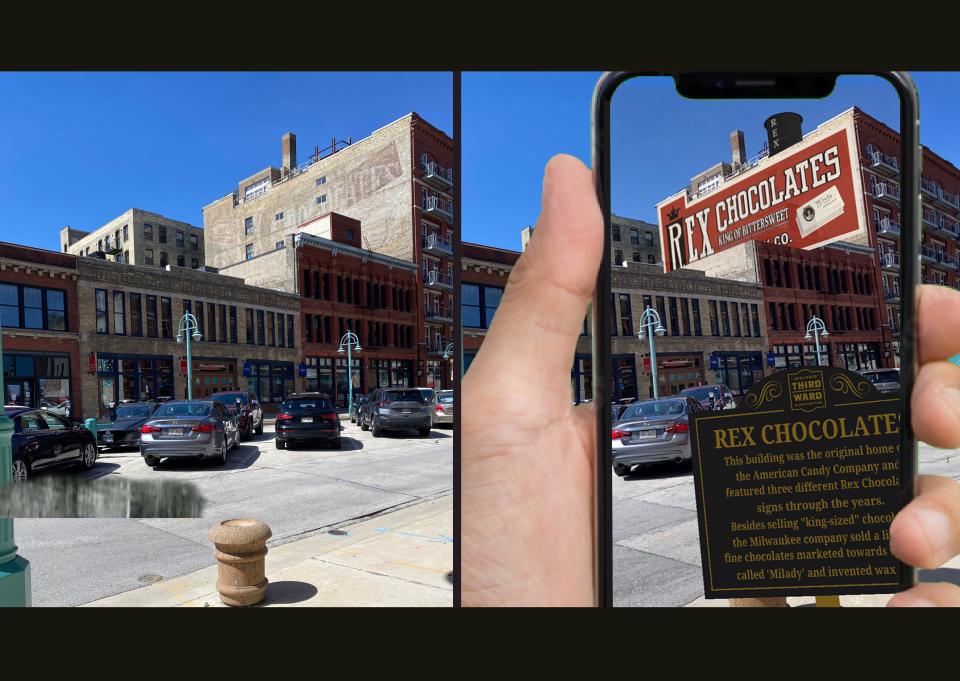New augmented reality walking tour reveals what Third Ward ghost signs used to look like
Mike Roe, the executive creative director for Milwaukee marketing agency Hoffman York, got interested in ghost signs when he noticed one outside his office window in the Third Ward, and then started noticing them everywhere in the neighborhood.
Ghost signs are faded advertisements that were painted on the outside of buildings decades ago, the remnants of which can still be seen.
"These signs were like the original out-of-home advertisements before TV, before social media, when you'd paint a big message on the side of your building to say, 'These are things we sell,'" Roe said. "And now it's like this art form of a part of history."
As his interest in the ghost signs grew, Roe started talking to people at the Historic Third Ward Association and learned about some of the factors that make the old, faded signs so prevalent in the Third Ward — including the fact that the area is a federally protected historic district and that it has a concentration of brick buildings built after a fire in 1892 destroyed hundreds of wooden buildings.
Roe wondered if there was a noninvasive way to preserve the signs before they completely fade away so people can see what they looked like in their glory days. With the help of augmented reality technology, he and some coworkers created a ghost sign tour of 13 signs on 10 buildings in the Third Ward. Now people can scan a QR code on a paper map or a mobile link, hold up their phone to a building, and see what the ghost sign used to look like.
Here's what Roe had to say about the tour and his fascination with ghost signs.

How did you learn what the ghost signs used to look like?
Most of the signs are now illegible so I had to find old photographs, some of them century-old. And when you look for those photos, they're usually of other things. So you're sifting through all these old photographs to try to catch these buildings in the background.
I found all these photos at the Milwaukee Public Library and the Milwaukee County Historical Society and the Wisconsin Historical Society. I've never had an excuse to really explore those places before, but whenever I would tell the staff there what I was looking to do, everyone was so friendly and excited and happy to help.
Once we found enough photos for reference, our designers and art directors re-created the signs. The augmented reality work was challenging because that type of technology works really well for closer stuff, like when you go to a furniture store website and they show you what your furniture would look like in your living room. But we were trying to use the technology on a much bigger scale, to show what something would look like on the side of a whole building. The developers used geolocation and got it worked out so when you use your phone to look at the side of the building, the sign will sit there and when you move, it stays anchored and doesn't float around.
What can people expect when they go on the tour?
People can go to the Historic Third Ward Association, 525 E. Chicago St., to get a copy of the map. We're also hoping to partner with other places in the Third Ward, like the Milwaukee Public Market, 400 N. Water St., so people spending time in the Third Ward can pick up a map to either take a walking tour of the signs or use the mobile link (augmentedhistory.org) when they come across the buildings.
Then, as you come up to one of the buildings on the map, you use your phone to scan the QR code for that building, and hold up your phone to the ghost sign, and it will overlay the image of what the sign used to look like.
Will there be more ghost sign tours in the future?
What's great about having this tour in the Third Ward is, in addition to so many ghost signs, people can get something to eat, go to the shops and the galleries, spend some time walking around and have a fun adventure.
We've had kind of tunnel vision on creating this experience and making it live, and now, after doing a soft launch, we're realizing how many people are really enthusiastic about this. A lot of people have told me about their passion for this art form, so we'd love to feed that passion as much as we can. And I've noticed there are a lot of ghost signs in the Fifth Ward as well. A part of me would love to expand the tour, and I do love the idea of finding other ghost signs in Milwaukee.
How do you explain your fascination with ghost signs?
I would never have called myself a history buff, but there's something about these signs. I look at them and then when I see what they used to look like, I think about that company and what they used to sell and what it used to be like.
Like one of the buildings had these two Rex Chocolates signs, which was this big chocolate manufacturer. When I was researching them, I found magazine and newspaper articles about them, then on eBay, I found some of their old candy tins. I love to see that there was this whole experience, this whole brand that few people know about now that used to be this giant of Milwaukee industry.
I've got to watch out. It's definitely a rabbit hole.
This article originally appeared on Milwaukee Journal Sentinel: Historic Third Ward ghost sign walking tour uses augmented reality

